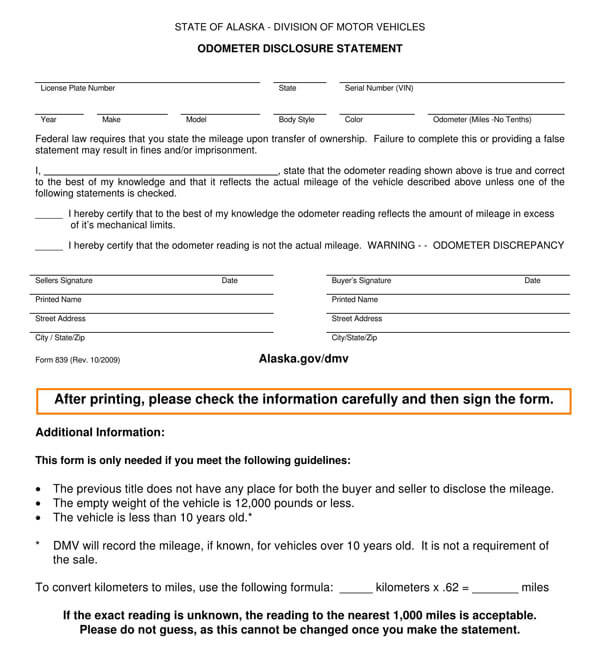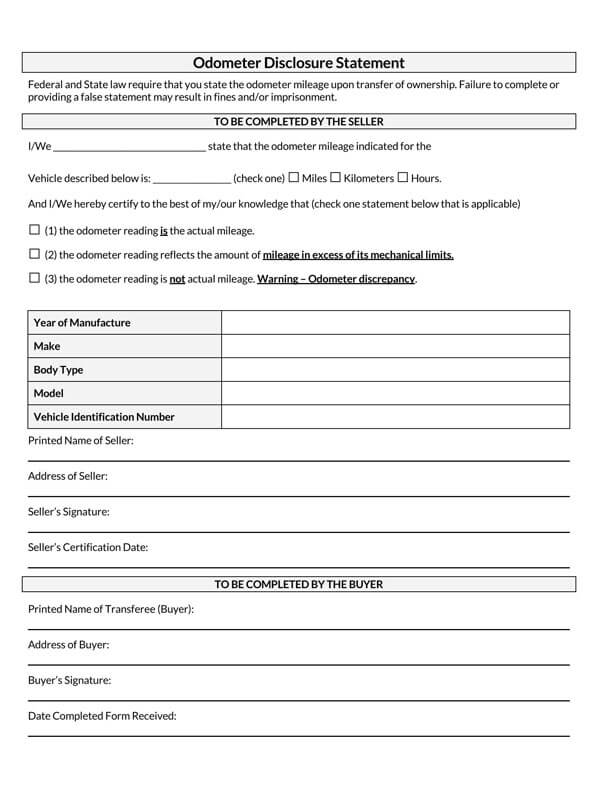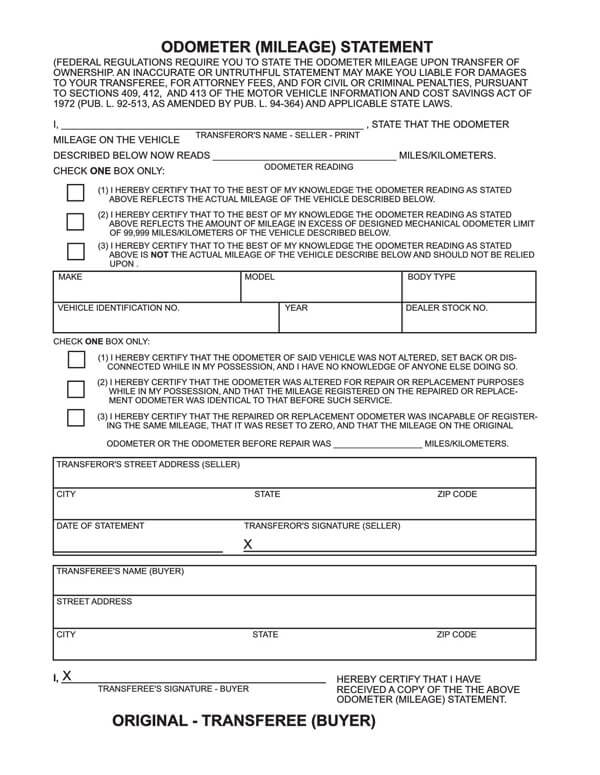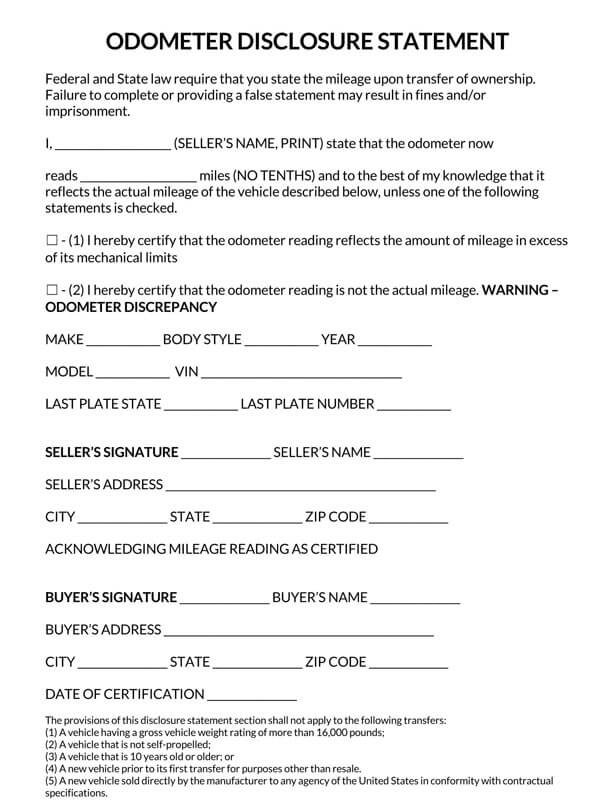An Odometer Disclosure Statement is used to declare a vehicle’s mileage as indicated by the vehicle’s odometer.
It can also be used to declare whether the vehicle’s odometer displays an accurate reading. Furthermore, the sale of commercial vehicles with regulated weight limits as well as vehicles sold directly to an agency by a manufacturer, does not require the completion of an odometer disclosure statement. Additionally, a new vehicle transferred before its first retail sale does not need an odometer disclosure statement.
Basically, an odometer disclosure statement is a statement obligated for the seller to fill accurately at the point of sale of a vehicle. The odometer disclosure statement must be attached to the vehicle’s bill of sale. Vehicles that require an odometer disclosure statement to be attached to their bill of sale at the point of sale are typically cars and any other vehicle that weighs below 16,000 pounds(lbs.) and which have been in use for the past 10 years or more.
It is a basic requirement for the sale of cars and other similar vehicles, and according to federal law, all vehicles that fall within the category specified above require an odometer disclosure statement to finalize the sale. In addition, the odometer disclosure statement is required when the buyer registers the vehicle. During registration of the vehicle, the buyer will be required to present the odometer disclosure statement along with the title and bill of sale.
Federal law requires the completion of the odometer disclosure statement for the sale of regulated vehicles. This means that violation of the odometer disclosure requirement attracts fines to the seller and/or possible imprisonment. The odometer disclosure statement is required because of cars that have an analog odometer, or digital car computers that can be tampered with. The Federal Truth Mileage Act was signed into law to combat the unethical act of tampering with a vehicle’s odometer to trick buyers.
The odometer disclosure statement may be described using other terms such as:
- Odometer statement.
- Odometer disclosure form
Federal Law – 49 U.S. Code Chapter 327 (Odometers)
Each state has its laws regarding the odometer disclosure statement, and as such, every state has the liberty to recommend its own odometer disclosure statement or use the federal odometer disclosure statement. Some states have issued their own odometer disclosure forms, and these forms are required by the department of motor vehicles for vehicles to be registered or titles to be issued. However, in some states where the government has not issued an odometer disclosure form, a generic odometer disclosure statement can be used. Hence, it is important for both the buyer and the seller to confirm if their state has its own odometer disclosure form, provided at the local Department of motor vehicles (DMV)
Odometer Disclosure Statement Templates – By State
Download odometer disclosure statement templates from here:
General Forms
Writing the Odometer Disclosure Statement
An odometer disclosure statement is a legal form that may attract a penalty if done incorrectly. Hence, the detailed step-by-step guide help both the buyer and seller accurately prepare the odometer disclosure statement.
The steps include:
Identifying the seller
The seller of a vehicle is firstly required to provide their personal information as well as ensure that the details stated in the disclosure are true and accurate at least to the best of the selling party’s knowledge as the seller could be subject to legal action in case of violation as discussed earlier in the article in detail. The seller is required to provide their full names and mailing address. The location of signing the odometer disclosure statement, as well as the bill of sale should also be specified.
Documenting the odometer reading
The odometer reading displayed on the vehicle’s odometer should be documented on the disclosure statement by rounding off the number of miles to the nearest tenth. The seller is also required to certify that the odometer reading of the vehicle at the time of signing the bill of sale and filing the odometer disclosure statement is accurate.
The seller can indicate If the reading documented in the odometer disclosure statement is the actual mileage of the vehicle or not. If the seller is aware that the odometer reading is inaccurate, the seller must indicate the discrepancy. If the odometer shows a blank display that is unreadable or the mileage displayed by the odometer is in excess of the vehicle’s mechanical limits (the odometer reading rolls over), or if the odometer is not in proper working condition, then the reading displayed by the odometer should be specified as “not actual” in this section of the disclosure statement.
Vehicle information
This step of preparing an odometer disclosure statement involves providing all forms of descriptive information apart from the odometer reading that helps to identify the vehicle. Descriptive information that identifies the vehicle includes the make of the vehicle, the body style of the vehicle, and the year of the vehicle. Other information includes the model and vehicle identification number, the license plate information, including the state where the last license plate of the vehicle was issued, as well as the last license plate number should also be included.
Verifying the odometer disclosure statement
For the odometer disclosure statement to be valid, both the buyer and the seller are required to sign the documents in addition to providing some basic information. There should be two separate sections provided for the signing of this statement. The first section should require the seller’s signature, as well as all the basic information which includes the seller’s address, city-state, and zip code.
The seller will be required to fill in the physical Street address which includes the street building, number, and street number if applicable. The second portion should require the buyer’s signature. The buyer will only be required to fill out this section once the buyer has viewed the odometer reading and reviewed the odometer disclosure statement. The buyer may then proceed to sign their name and their signature in addition to other basic information which includes the buyer’s physical address, state, city zip code, and the date the odometer disclosure statement was issued.
Attach the odometer disclosure statement to the bill of sale
Once the odometer disclosure statement has been completed and signed by both the seller and the buyer, the seller may then proceed to attach it to the bill of sale. By attaching the odometer disclosure statement to the bill of sale, the seller verifies that the odometer information provided to the buyer is accurate to the best of the seller’s knowledge in accordance with federal law.
The buyer keeps the original odometer disclosure statement, while the seller should document a copy for record-keeping purposes. Providing the odometer disclosure statement to the buyer to keep is important as most States require a buyer to have the original certificate of title in addition to an odometer disclosure statement attached to the vehicle’s bill of sale in order to be able to obtain a new title and registration for the vehicle.
If the seller is a car dealer, it is advisable to retain all sold vehicle records and odometer disclosure statements for a minimum of five years in case of an inspection by a transportation regulation agency. Retaining a copy of the odometer disclosure statement is not required, however, it is a good business practice that may save the seller some trouble in the future.
Why Accuracy of Odometer the Disclosure Statement Matters?
The odometer disclosure statement is meant to give the buyer an idea of what the vehicle’s mileage is therefore the seller has the responsibility of providing the most accurate odometer reading to the buyer. If the vehicle in question does not have an accurate reading due to the odometer reaching its maximum limit and therefore it starting over, the seller is obligated to disclose as much of this information clearly to the buyer as possible.
In addition, if the odometer of the vehicle has been damaged or replaced, the seller is obligated to inform the buyer in that case too. Also, if the seller is unsure about the vehicle’s true mileage due to a damaged odometer or unknown vehicle past history, the seller should indicate that the odometer reading is not the actual mileage.
It is important to note that odometer tampering is regarded as a crime punishable by imposing fines and/or imprisonment. If the seller gives an inaccurate odometer reading without specifying that it is not the actual mileage, it may be regarded as odometer tampering.
If the seller is not aware of the true mileage of the vehicle, the seller is obligated to indicate as such on the title at the point of sale of the vehicle and is in no way supposed to justify the unclear transfer of ownership by conveyance of false information in such conditions. The seller may also acquire a history report on the vehicle to compare the current reading with the last recorded mileage and provide this information to the buyer.
Frequently Asked Questions
What if I don’t have a vehicle title?
If the title of the vehicle is not available, the seller may apply for a duplicate title. The required form for obtaining a duplicate title varies from state to state and the seller should contact the local authorities in their local area to find out the procedure for obtaining a duplicate title.
Is the odometer reading the same as mileage?
In a situation where all things are working properly, and the odometer is not damaged or replaced, the odometer reading is the vehicle’s mileage. However, if the odometer has been damaged or replaced, the values displayed by the odometer are not accurate mileage. Hence, the seller is required to disclose to the buyer if the odometer has been replaced or damaged.



